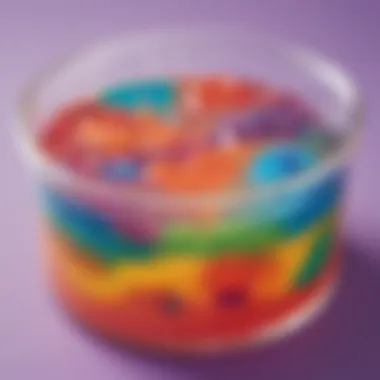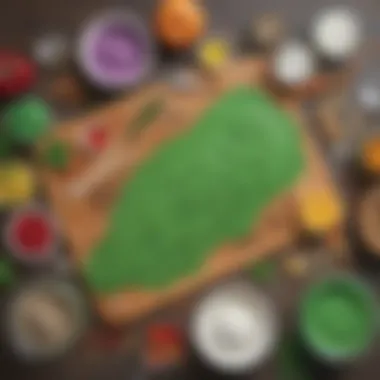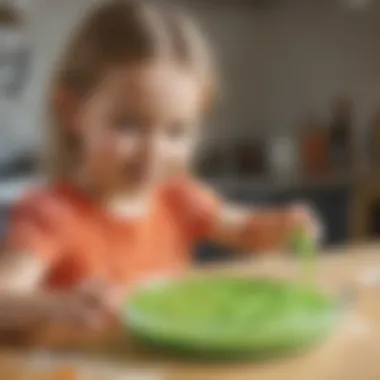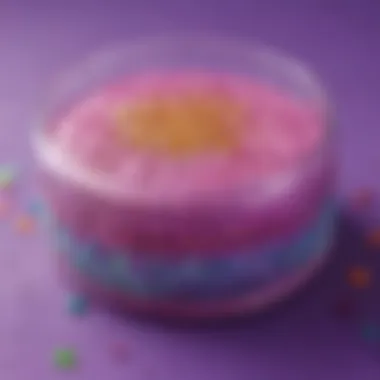Unleash Your Creativity: Crafting an Engaging Slime Recipe for Kids


Science Fun Facts
Exploring the world of slime opens up a realm of intriguing scientific fun facts. Did you know that the first synthetic polymer, called Bakelite, was developed in 1907 by Belgian chemist Leo Baekeland? This laid the foundation for modern plastics, including those used in making slime. Understanding the chemical reactions behind slime formation can be a gateway to deeper scientific curiosity among young minds. Dive into the fascinating world of polymers and non-Newtonian fluids through the creation of your custom slime recipe!
Discover the Wonders of Science
Creating your own slime recipe isn't just about fun; it's also a doorstep to understanding various scientific concepts. From exploring the properties of polymers to witnessing non-Newtonian fluids in action, kids can grasp fundamental scientific principles through this engaging DIY project. By mixing ingredients and observing their reactions, children get hands-on experience in chemistry. With educational videos and interactive learning tools, they can delve deeper into the science behind slime-making and its real-life applications.
Science Quiz Time
To make learning even more dynamic, engage in an interactive science quiz focused on slime and its properties. Test your knowledge with multiple-choice questions like, 'What type of substance is slime: solid, liquid, or gas?' Such brain teasers not only add an element of fun but also reinforce the scientific concepts learned during the slime-making process. Unlock the potential of gamified learning and challenge yourself with quirky questions that make science an exciting adventure!
Science Experiment Showcase
Let's step into the realm of science experiment showcase where the magic of slime-making unfolds. Follow step-by-step instructions meticulously detailing the materials needed for your DIY slime recipe. From safety tips to precautions, ensure a secure environment for the experiments. By immersing in fun and engaging experiments, children can unleash their creativity while developing essential skills in following procedures and understanding scientific principles.
Introduction
Engage with the possibilities of creating your custom slime recipe - a journey into creativity and experimentation for kids. This exploration offers more than just gooey fun; it presents a hands-on learning experience where children can delve into the scientific wonders of mixing common household ingredients. Unravel the fascination that homemade slime holds for young minds, from the sensory delight it provides to the educational insights gained through this tactile activity.
Understanding the Fascination with Slime
The sensory appeal of slime
Delve into the captivating world of slime texture and elasticity, where its stretchy nature offers a unique tactile experience for young hands. The elasticity of slime provides a therapeutic sensory input that can soothe and engage children as they explore its malleable properties. This tactile engagement fosters sensory exploration and fine motor skills development, making slime a popular choice for sensory play activities among children.
Educational benefits of making slime
Discover the educational value embedded in creating slime as children engage in simple chemistry concepts while mixing ingredients. The process of combining substances to form a new material introduces basic scientific principles in a fun and interactive manner. Through slime-making, kids can grasp foundational concepts of measurement, reactions, and material transformations, fostering a sense of curiosity and experimentation.
Popularity of homemade slime among kids
Homemade slime has garnered a widespread appeal among kids due to its versatile nature and customizable features. This DIY activity empowers children to express their creativity by choosing colors, textures, and additives. The freedom to customize slime recipes based on personal preferences sparks interest and enthusiasm, turning slime-making into a creative outlet that nurtures individuality and imagination.
Importance of DIY Projects for Children
Encouraging creativity and experimentation
Engage children in a realm of boundless creativity by encouraging them to explore unconventional mixtures and textures through DIY slime projects. The hands-on nature of creating slime allows kids to experiment with different ingredients, fostering a sense of curiosity and innovation. By embarking on this creative journey, children develop confidence in their creative abilities and learn to think outside the box.
Hands-on learning experiences
Immerse children in a world of hands-on learning experiences through interactive slime-making sessions that promote sensory exploration and scientific inquiry. The process of measuring, pouring, and mixing ingredients provides practical learning opportunities that enhance fine motor skills and cognitive development. This hands-on approach to learning not only reinforces academic concepts but also nurtures a sense of independence and self-directed learning.
Promoting problem-solving skills


Encourage children to tackle challenges and overcome obstacles as they engage in the problem-solving process inherent in slime-making activities. From adjusting ingredient quantities to troubleshooting slime consistency issues, kids develop critical thinking skills and resilience in the face of setbacks. Through experimentation and observation, children learn the value of persistence and adaptability, ultimately honing their problem-solving abilities in a fun and engaging manner.
Getting Started: Gathering Supplies
When embarking on the journey of creating your own slime recipe, the essential first step is gathering all the necessary supplies. Ensuring that you have the right ingredients and tools will make the process smooth and enjoyable. From Elmer's glue to Borax, each item plays a crucial role in achieving the desired slime consistency. This section will delve into the significance of Gathering Supplies, highlighting the key elements required for a successful slime-making session.
Essential Ingredients for Slime
Elmer's glue
Elmer's glue serves as the foundation for any slime recipe, providing the necessary base for the final product. Its adhesive properties help bind the ingredients together, resulting in a stretchy and pliable texture. One of the main advantages of Elmer's glue is its widespread availability and affordability, making it a popular choice among DIY enthusiasts. Despite its minor shortcomings, such as potential stickiness on hands, Elmer's glue remains a staple ingredient due to its consistency and reliability.
Borax or alternative activators
Borax or alternative activators act as the activator in slime-making, facilitating the bonding process between the glue molecules. Borax, in particular, is commonly used but has raised safety concerns, leading to the popularity of alternative options like liquid starch or contact lens solution. The key characteristic of Borax lies in its effectiveness in creating slime with the desired consistency. However, its potential irritant nature highlights the need for caution when handling. Exploring alternative activators provides flexibility and caters to individuals with sensitivities or preferences.
Food coloring or glitter (optional)
To add a touch of personalization and flair to your slime, food coloring or glitter serves as the perfect option. While optional, these additives enhance the visual appeal of the slime, making it more engaging for young creators. Food coloring allows for a vibrant spectrum of colors, while glitter introduces a sparkling effect. The unique feature of these additives is the customization they offer, allowing children to unleash their creativity and design unique slime creations. However, moderation is key to prevent overpowering the slime's texture with excessive coloring or glitter.
Tools and Containers
Mixing bowls
Mixing bowls are essential for combining the ingredients and achieving a uniform slime mixture. Their smooth surfaces make mixing effortless, ensuring that the glue and activator are evenly distributed. The key characteristic of mixing bowls is their versatility, accommodating various batch sizes and facilitating easy cleaning after use. While their advantages include convenience and practicality, potential disadvantages may include limited mixing space for larger projects.
Measuring cups and spoons
Accurate measurements are crucial in slime-making to maintain the desired consistency and texture. Measuring cups and spoons provide precision in portioning ingredients, ensuring that the recipe remains balanced. The key characteristic of these tools is their calibration markings, allowing for precise measurements of both liquid and dry components. While their advantages include ease of use and accurate results, potential disadvantages may include the need for multiple sets for different measurements.
Storage containers
After creating your slime masterpiece, proper storage is vital to maintain its freshness and prevent drying out. Storage containers offer a secure and airtight environment to preserve the slime for future play sessions. The key characteristic of storage containers is their sealable lids, safeguarding the slime from exposure to air and moisture. Their advantages include organization and longevity of the slime, while potential disadvantages may include limited space for storing multiple slime batches.
Mixing Your Slime
Mixing your slime is a crucial element of the slime-making process, as it determines the final texture and consistency of the slime. Proper mixing ensures that all ingredients are evenly distributed, creating a smooth and stretchy slime that is enjoyable to play with. This section will delve into the step-by-step process of mixing your slime, emphasizing accuracy and precision to achieve the perfect result.
Step-by-Step Instructions
Measuring ingredients accurately
In the realm of slime making, measuring ingredients accurately is the cornerstone of a successful slime recipe. The precise measurement of components such as glue and activator is essential to achieve the desired slime consistency. Ensuring accuracy in measurements guarantees a slime that is neither too sticky nor too stiff, providing the ideal tactile experience for children. Measuring ingredients accurately also sets the foundation for experimenting with different slime textures and customization options, allowing young creators to unleash their creativity with confidence.
Creating the slime base
The creation of the slime base forms the heart of the slime-making process. This step involves combining glue with activator to initiate the chemical reaction that transforms the mixture into slime. The slime base sets the stage for experimentation, offering a blank canvas for adding colors, textures, and scents. Understanding the intricacies of creating the slime base is fundamental to mastering the art of slime making, enabling children to explore the science behind the transformations occurring within the mixture.


Adding color or glitter
Adding color or glitter to slime injects a burst of creativity and personalization into the crafting experience. This step allows children to customize their slime creations, infusing them with vibrant hues or sparkling embellishments. The addition of color or glitter not only enhances the visual appeal of the slime but also creates unique sensory experiences for young enthusiasts. Exploring different color combinations and glitter options opens up a world of possibilities, turning slime making into an imaginative and artistic endeavor.
Tips for the Perfect Consistency
Adjusting activator quantity
Fine-tuning the activator quantity is a critical aspect of attaining the perfect slime consistency. Gradually adding activator while mixing the slime base enables children to observe the texture transformation and make real-time adjustments. The ability to adjust activator quantity empowers young slime makers to troubleshoot and adapt their slime recipe to achieve the desired stretchiness and pliability. Balancing the activator amount is key to mastering the art of slime making, ensuring a satisfying end result that meets kids' tactile expectations.
Kneading and mixing techniques
Effective kneading and mixing techniques play a pivotal role in homogenizing the slime mixture and achieving the desired elasticity. Kneading the slime with precision helps distribute the ingredients uniformly, resulting in a smooth and cohesive slime texture. Exploring various kneading and mixing methods allows children to discover their preferred approach, fostering hands-on learning and sensory exploration. Implementing the right kneading and mixing techniques is instrumental in perfecting the slime consistency, encouraging children to engage with the crafting process creatively.
Troubleshooting common issues
Troubleshooting common issues in slime making equips young creators with the resilience to overcome challenges and adapt their recipes for optimal results. Identifying and addressing issues such as stickiness, stiffness, or lack of stretchiness enhances problem-solving skills and critical thinking abilities. Offering practical solutions to common slime-making hurdles empowers children to experiment fearlessly and refine their slime recipes through trial and error. Developing troubleshooting skills fosters a growth mindset in young learners, instilling a sense of persistence and innovation in their DIY endeavors.
Customization and Experimentation
Customization and Experimentation play a pivotal role in the slime-making process. It allows kids to personalize their slime creation, fostering creativity and exploration. By experimenting with different textures, colors, and additives, children can enhance their sensory experience and develop their artistic sensibilities. Additionally, customization promotes critical thinking as kids make decisions on ingredient combinations. This hands-on approach to customization not only provides a fun activity but also encourages problem-solving skills and innovation throughout the DIY project.
Adding Texture and Effects
Incorporating foam beads or sequins:
Incorporating foam beads or sequins adds a tactile dimension to the slime, creating a unique sensory experience for children. These elements introduce variety in texture, making the slime more engaging to touch and play with. The lightweight properties of foam beads and the reflective nature of sequins enhance the visual appeal of slime, making it visually stimulating. While foam beads add a crunchy texture, sequins offer a shiny and glitzy effect. Their versatility allows children to experiment with different combinations, fostering creativity and providing endless possibilities for customization.
Scented oils or extracts:
Scented oils or extracts contribute to the sensory experience of slime by introducing pleasant fragrances. These additions can evoke various scents, such as fruity, floral, or sweet, enhancing the overall enjoyment of playing with slime. Scented oils also have calming properties, adding a sensory relaxation element to the slime-making process. While some scents may be energizing, others can promote a sense of calmness and tranquility, making scented slime a versatile option for children with different preferences.
Experimenting with different additives:
Experimenting with various additives allows children to explore the chemistry behind slime-making. By introducing different elements like baking soda for a fluffy texture or saline solution for improved elasticity, kids can observe how these additives interact with the base ingredients. This hands-on experimentation fosters a deeper understanding of the scientific principles involved in slime formation. Additionally, trying out new additives encourages curiosity and inquiry, driving kids to hypothesize and test different combinations, further enhancing their learning experience.
Creating Theme-Based Slime
Seasonal and holiday-inspired slime:
Designing slime based on seasonal themes or holidays adds a festive touch to the slime-making activity. By incorporating colors and elements associated with specific celebrations or seasons, children can explore the cultural significance behind each theme. Seasonal and holiday-inspired slime encourages creativity and cultural awareness, allowing kids to connect with various traditions through hands-on engagement. Additionally, themed slime projects offer a fun way to celebrate special occasions with family and friends, creating memorable and educational experiences.
Galaxy or unicorn-themed slime:
Creating galaxy or unicorn-themed slime introduces a magical and whimsical element to the DIY project. These themes inspire imagination and fantasy, allowing kids to explore colorful and sparkly additions to their slime. Galaxy slime often features shimmering glitter and dark hues resembling outer space, while unicorn-themed slime incorporates pastel colors and iridescent elements reminiscent of mythical creatures. The whimsy and charm of these themes provide children with an avenue to express their creative side and create otherworldly slime experiences.
Glow-in-the-dark varieties:


Glow-in-the-dark slime offers a novel twist to traditional slime-making, adding an element of excitement and wonder. This type of slime contains phosphorescent materials that absorb light and emit a luminous glow in the dark, creating a mesmerizing visual effect. Glow-in-the-dark varieties enhance sensory exploration, especially in dimly lit environments, captivating children with their radiant appearance. Additionally, experimenting with glow pigments or additives encourages scientific inquiry into luminescence, sparking interest in light-related phenomena among young learners.
Safety Precautions and Cleanup
Safety precautions and cleanup are paramount when engaging in DIY projects like making slime, ensuring a safe and tidy environment for children to learn and have fun. By adhering to proper safety measures, you can create a worry-free space for creativity to flourish. Understanding the significance of these aspects guarantees a smooth and secure experience throughout the slime-making process.
Guidelines for Safe Slime Making
Supervision for young children
Supervision for young children is a critical component of safe slime making, offering a watchful eye to oversee the project's progress and intervene if needed. This ensures that children can enjoy the activity under responsible guidance, fostering a sense of security and reassurance. With supervision, kids can explore their creativity freely while parents or caregivers monitor the process, enhancing the overall educational value of the project.
Proper storage of ingredients
Proper storage of ingredients contributes significantly to the safety and longevity of slime-making materials. Keeping ingredients securely stored in designated containers prevents accidental spills or exposure, mitigating potential risks and maintaining the integrity of the supplies for future projects. Emphasizing the importance of organized storage instills good habits in children and cultivates a sense of responsibility in handling crafting materials.
Handwashing after play
Handwashing after play is a fundamental hygiene practice that promotes cleanliness and prevents the spread of germs. Encouraging children to wash their hands after interacting with slime not only keeps them safe from potential contaminants but also instills lifelong habits of personal hygiene and care. By incorporating handwashing into the post-play routine, parents can ensure a seamless transition from fun crafting activities to essential cleanliness practices.
Cleaning Up After Slime Fun
Ensuring a thorough cleanup after slime fun is essential to maintain a tidy and organized workspace, prolonging the lifespan of materials and ensuring a safe environment for future projects. By following effective cleanup routines, you can streamline the process and minimize mess, enabling a seamless transition from creative exploration to a pristine setting for the next activity.
Removing slime residue
Removing slime residue requires patience and gentle techniques to eliminate any traces of the gooey substance. By using appropriate cleaning agents and methods, you can effectively clean surfaces and tools, restoring them to their original condition. Addressing residue promptly ensures a fresh start for the next crafting session, guaranteeing a clean and inviting workspace for continued creative endeavors.
Stain removal tips
Stain removal tips offer invaluable guidance on tackling stubborn slime stains, empowering you to combat discoloration and maintain the aesthetics of your work area. By leveraging proven stain removal strategies, you can address spills and mishaps with confidence, preserving the cleanliness and visual appeal of your crafting space. Incorporating these tips into your cleanup routine equips you with the tools to handle potential staining incidents effectively and efficiently.
Storage solutions
Effective storage solutions play a crucial role in preserving slime-making supplies and equipment, ensuring they remain organized and accessible for future use. By implementing strategic storage solutions, you can maximize space efficiency and protect materials from damage or loss. With well-organized storage, you can streamline the crafting process, saving time and effort while optimizing the functionality of your DIY workspace.
Conclusion
Creating your homemade slime opens a world of creativity and learning for kids. The tactile experience of concocting this gooey substance engages children's senses, fostering an appreciation for different textures and consistencies in materials. Through this DIY project, young minds grasp scientific concepts such as chemical reactions and polymers in a hands-on manner, making the educational benefits tangible and exciting. The homemade slime craze among kids stems from the joy of crafting something unique and personalized, promoting ownership and pride in their creations. It serves as a gateway to exploring creativity and fine-tuning problem-solving skills, instilling a sense of accomplishment in youngsters as they witness their ingredients transform into a stretchy, vibrant masterpiece.
Enjoy Your Homemade Slime
Benefits of homemade slime
Homemade slime offers a wide array of benefits beyond its entertaining appeal. It provides a safe and supervised platform for children to engage in sensory play, enhancing their tactile sensitivity and fine motor skills. Furthermore, homemade slime encourages experimentation and creativity, allowing kids to mix colors, textures, and scents to create a personalized sensory experience. The simplicity of crafting slime fosters independence in children, boosting their confidence as they navigate the process from start to finish, nurturing a sense of achievement. Moreover, homemade slime serves as a non-toxic alternative to store-bought versions, ensuring peace of mind for parents regarding the ingredients used in the crafting process.
Bonding through DIY projects
Engaging in DIY projects like making homemade slime not only entertains children but also cultivates bonding experiences. Parents and caregivers participating in the slime-making process share quality time with their children, fostering communication and collaboration. This shared activity strengthens the parent-child relationship, creating memories and a sense of togetherness through a fun and interactive medium. DIY projects provide a platform for parents to scaffold learning experiences, offering guidance and support while children explore their creativity, promoting a nurturing and supportive environment for growth and development.
Continuing the experimentation
Continuing the experimentation with homemade slime encourages children to delve deeper into the realm of creativity and scientific exploration. It instills a sense of curiosity and wonder as children tweak recipes, test new additives, and observe the reactions that ensue. This ongoing experimentation fosters a growth mindset, teaching resilience in the face of failed attempts and inspiring perseverance in problem-solving. Through continuous experimentation, children hone their observation skills and critical thinking abilities, learning to question, predict, and analyze outcomes, paving the way for a lifelong love of learning and discovery.







